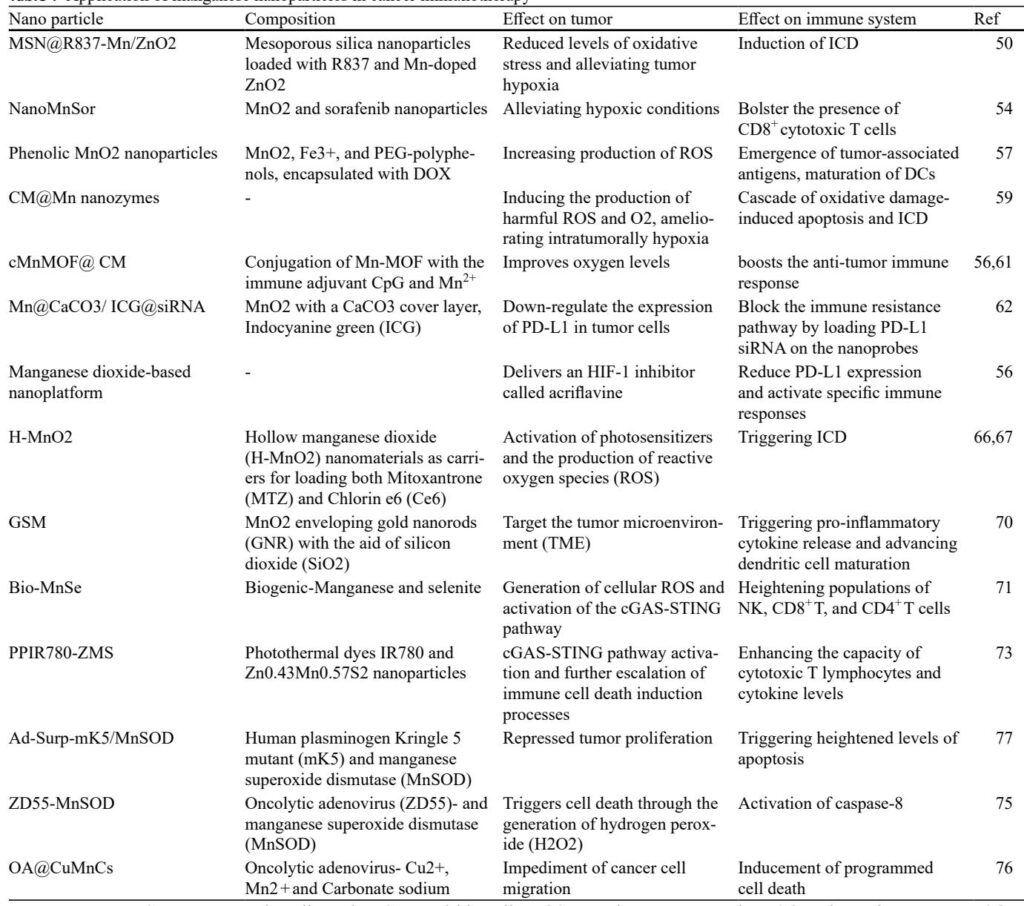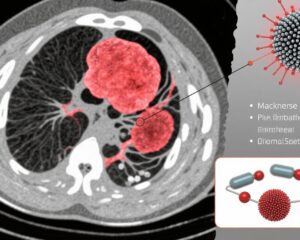Introduction
Cancer remains a leading global health challenge, with millions of new cases and deaths annually despite advances in traditional therapies such as surgery, chemotherapy, and radiotherapy. Immunotherapy has emerged as a promising treatment modality, particularly for solid tumors. However, its clinical success is often limited by systemic toxicities and an immunosuppressive tumor microenvironment (TME) that hinders immune cell infiltration and function.
The advent of nanotechnology has opened new avenues in cancer treatment, enabling targeted drug delivery and modulation of the TME. Among various materials, manganese (Mn), an essential trace element, has gained attention due to its unique biological and immunomodulatory properties. Recent evidence highlights the role of manganese nanoparticles (Mn-NPs) in enhancing immune responses, facilitating immunogenic cell death (ICD), and improving the efficacy of immune checkpoint inhibitors (ICIs) and phototherapies. This article provides a comprehensive overview of the mechanisms by which manganese and Mn-NPs advance cancer immunotherapy, delineates their integration with existing therapeutic strategies, and discusses challenges and future prospects in clinical translation.
Biological Role of Manganese and Mn Nanoparticles
Manganese is vital for numerous physiological processes, including enzymatic activities involving superoxide dismutase and arginase. Intracellular Mn predominantly exists as $plus2$ ions stored within organelles like the Golgi apparatus and mitochondria. Key transporters such as DMT1 facilitate Mn cellular uptake. Mn exhibits diverse oxidation states that underpin its catalytic versatility.
Manganese oxide nanoparticles, particularly manganese dioxide ($MnO2$), exhibit redox activities that can exploit the acidic and reductive features of the TME. These nanoparticles catalyze the depletion of glutathione (GSH) and hydrogen peroxide ($H2O2$), alleviating hypoxia and generating reactive oxygen species (ROS) that induce oxidative stress in tumor cells. This catalytic activity leads to the release of free Mn ions that further engage intracellular immune pathways.
Manganese Modulation of Immune Responses
A critical mechanism of Mn-mediated immune activation involves the cGAS/STING pathway. Cytosolic double-stranded DNA (dsDNA), released during cancer cell damage, activates the DNA sensor cGAS, culminating in STING-mediated type I interferon production. Mn enhances cGAS enzymatic activity and strengthens STING/cGAMP binding affinity, promoting dendritic cell (DC) maturation and cytotoxic T lymphocyte (CTL) activation. In vivo, Mn supplementation amplifies tumor infiltration of activated CD8+ T cells and natural killer (NK) cells, significantly enhancing antitumor immunity.
Additionally, Mn-NPs modulate the immunosuppressive TME by decomposing tumor-overexpressed $H2O2$ into oxygen, mitigating hypoxia and repolarizing tumor-associated macrophages towards the proinflammatory M1 phenotype. The depletion of GSH reduces the antioxidative defense of tumor cells, enhancing oxidative damage. Mn further increases ROS production through mitochondrial effects, culminating in ICD and release of damage-associated molecular patterns (DAMPs) that promote innate and adaptive immune responses.
Manganese in Combination Immunotherapies
Mn and Mn-NPs serve as efficient adjuvants and carriers in multifaceted cancer immunotherapy platforms:
1. Tumor-targeting Monoclonal Antibodies (mAbs): Mn-doped nanoparticles conjugated with tumor-specific mAbs enable selective delivery and imaging, enhancing antibody-dependent cytotoxicity and phagocytosis. These platforms improve therapeutic targeting, especially in heterogeneous tumors expressing receptors like HER2/neu and EGFR.
2. Immune Checkpoint Inhibitors (ICIs): Mn-NPs synergize with ICIs by transforming immunologically “cold” tumors into “hot” ones, increasing antigen presentation and CTL infiltration. Mn-mediated alleviation of tumor hypoxia and oxidative stress further sensitizes tumors to PD-1/PD-L1 blockade, improving response rates.
3. Immunogenic Cell Death (ICD) Inducers: Mn-NP platforms enhance ICD induction through controlled drug release, ROS generation, and oxygen supply, augmenting the release of tumor antigens and maturation of DCs. Combinational strategies integrating Mn with photodynamic and photothermal therapies have demonstrated robust antitumor immune activation.
4. Oncolytic Viruses (OVs): Engineered OVs expressing Mn superoxide dismutase (MnSOD) or combined with Mn-based nanomaterials exhibit amplified oncolytic activity by increasing oxidative stress within tumor cells and boosting immune infiltration, offering promise in overcoming OV resistance and enhancing systemic antitumor immunity.
Manganese as a Vaccine Adjuvant
Mn ions potentiate innate immune sensing via cGAS-STING and inflammasome pathways, facilitating effective antigen presentation and T cell priming. Mn-based nanocarriers boost both humoral and cellular responses in nanovaccine designs, enabling enhanced germinal center formation and pro-inflammatory cytokine secretion. Hybrid adjuvants combining Mn and immunostimulatory molecules have shown dual activation of immune pathways, providing opportunities for safer and more efficacious cancer vaccines.
Advanced Mn-based Nanoparticles for Drug Delivery and Imaging
Manganese-based magnetic nanoparticles offer multifunctionality as drug carriers and magnetic resonance imaging (MRI) contrast agents. Mn-doped ferrites exhibit superior T2 contrast and can be functionalized with targeting ligands for enhanced tumor accumulation via active targeting mechanisms. Hollow MnO2 nanoparticles facilitate stimulus-responsive drug release in acidic tumor environments. Despite their promise, the clinical translation of Mn-NPs necessitates thorough evaluation of biosafety, long-term biodistribution, potential neurotoxicity, and standardized synthesis protocols.
Challenges and Mitigation Strategies
Limitations in the clinical adoption of Mn-NPs include potential toxicity from accumulation, neurotoxic effects mimicking Parkinsonian syndromes, and immune-related adverse events (irAEs). These challenges underscore the necessity for precise dosing, targeted delivery systems, and comprehensive long-term preclinical safety assessments. Surface modifications with biocompatible coatings such as polyethylene glycol (PEG), human serum albumin (HSA), or hyaluronic acid (HA) improve stability and biocompatibility. Establishing standardized, environmentally friendly nanoparticle synthesis methods remains pivotal.
Conclusion and Future Perspectives
Manganese and its nanoscale derivatives herald a new frontier in cancer immunotherapy, functioning as immunomodulators, adjuvants, and drug delivery vehicles that uniquely address the challenges posed by the tumor microenvironment. Their ability to activate key immune pathways, potentiate ICD, and enhance existing therapies positions them as instrumental components of next-generation oncologic treatment regimens.
Future research should focus on elucidating detailed mechanisms of Mn-mediated immune modulation, optimizing nanoparticle design for targeted delivery and minimal toxicity, and advancing clinical trials to validate safety and efficacy. The concept of “Metal immunotherapy” introduced by manganese-based materials promises to revolutionize cancer treatment, potentially improving outcomes for patients with resistant or relapsed malignancies.
Reference
Moosavi Zenooz A, Eterafi M, Azarmi Giglou S, Safarzadeh E. Embracing cancer immunotherapy with manganese particles. Cell Oncol (Dordr). 2025 Aug;48(4):899-920. doi: 10.1007/s13402-025-01070-9. Epub 2025 May 21. PMID: 40397376; PMCID: PMC12238167.


